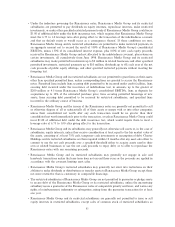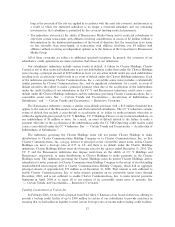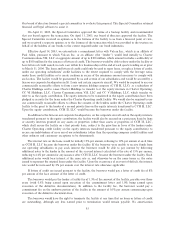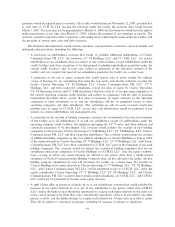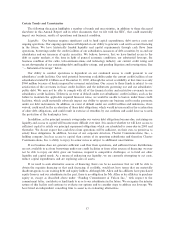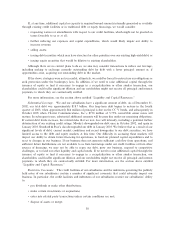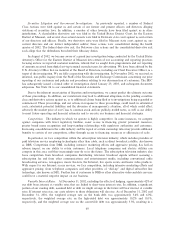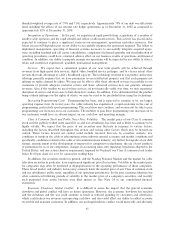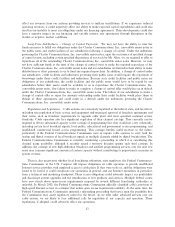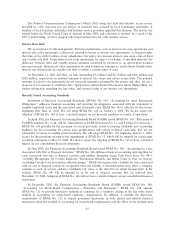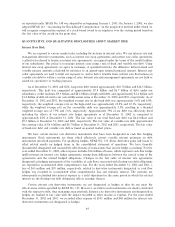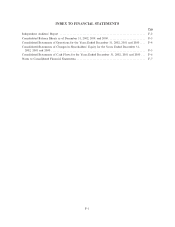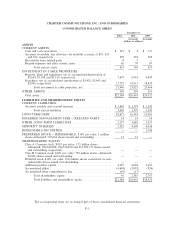Charter 2002 Annual Report Download - page 63
Download and view the complete annual report
Please find page 63 of the 2002 Charter annual report below. You can navigate through the pages in the report by either clicking on the pages listed below, or by using the keyword search tool below to find specific information within the annual report.blended weighted average rate of 7.9% and 7.6%, respectively. Approximately 79% of our debt was eÅectively
Ñxed including the eÅects of our interest rate hedge agreements as of December 31, 2002 as compared to
approximately 82% at December 31, 2001.
Integration of Operations. In the past, we experienced rapid growth from acquisitions of a number of
smaller cable operators and the rapid rebuild and rollout of advanced services. This activity has placed and is
expected to continue to place a signiÑcant strain on our management, operations and other resources. Our
future success will depend in part on our ability to successfully integrate the operations acquired. The failure to
implement management, operating or Ñnancial systems necessary to successfully integrate acquired opera-
tions, including headend and call center consolidation, completion of planned upgrades and standardization of
operating procedures, could have a material adverse eÅect on our business, results of operations and Ñnancial
condition. In addition, our ability to properly manage our operations will be impacted by our ability to attract,
retain and incentivize experienced, qualiÑed, professional management.
Services. We expect that a substantial portion of our near term growth will be achieved through
revenues from high-speed data services, digital video, bundled service packages, and to a lesser extent other
services that take advantage of cable's broadband capacity. The technology involved in our product and service
oÅerings generally requires that we have permission to use intellectual property and that such property not
infringe on rights claimed by others. We may not be able to oÅer these advanced services successfully to our
customers or provide adequate customer service and these advanced services may not generate adequate
revenues. Also, if the vendors we use for these services are not Ñnancially viable over time, we may experience
disruption of service and incur costs to Ñnd alternative vendors. In addition, if it is determined that the product
being utilized infringes on the rights of others, we may be sued or be precluded from using the technology.
Increasing Programming Costs. Programming has been, and is expected to continue to be, our largest
operating expense item. In recent years, the cable industry has experienced a rapid escalation in the cost of
programming, particularly sports programming. This escalation may continue, and we may not be able to pass
programming cost increases on to our customers. The inability to pass these programming cost increases on to
our customers would have an adverse impact on our cash Öow and operating margins.
Class A Common Stock and Public Notes Price Volatility. The market price of our Class A common
stock and the publicly-traded notes issued by us and our subsidiaries has been and is likely to continue to be
highly volatile. We expect that the price of our securities may Öuctuate in response to various factors,
including the factors described throughout this section and various other factors which may be beyond our
control. These factors beyond our control could include: Ñnancial forecasts by securities analysts; new
conditions or trends in the cable or telecommunications industry; general economic and market conditions and
speciÑcally, conditions related to the cable or telecommunications industry; any further downgrade of our debt
ratings; announcement of the development of improved or competitive technologies; the use of new products
or promotions by us or our competitors; changes in accounting rules; new regulatory legislation adopted in the
United States; and any action taken or requirements imposed by Nasdaq if our Class A common stock trades
below $1.00 per share for over 30 consecutive trading days.
In addition, the securities market in general, and the Nasdaq National Market and the market for cable
television securities in particular, have experienced signiÑcant price Öuctuations. Volatility in the market price
for companies may often be unrelated or disproportionate to the operating performance of those companies.
These broad market and industry factors may seriously harm the market price of our Class A common stock
and our subsidiaries' public notes, regardless of our operating performance. In the past, securities litigation has
often commenced following periods of volatility in the market price of a company's securities, and recently
such purported class action lawsuits were Ñled against us. See Note 24 to our consolidated Ñnancial
statements.
Economic Slowdown; Global ConÖict. It is diÇcult to assess the impact that the general economic
slowdown and global conÖict will have on future operations. However, the economic slowdown has resulted
and the slowdown and the war could continue to result in reduced spending by customers and advertisers,
which could reduce our revenues and operating cash Öow, and also could aÅect our ability to collect accounts
receivable and maintain customers. In addition, any prolonged military conÖict would materially and adversely
61


